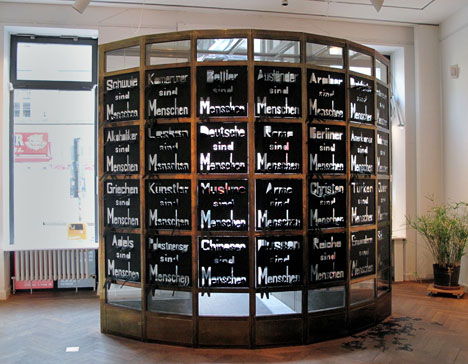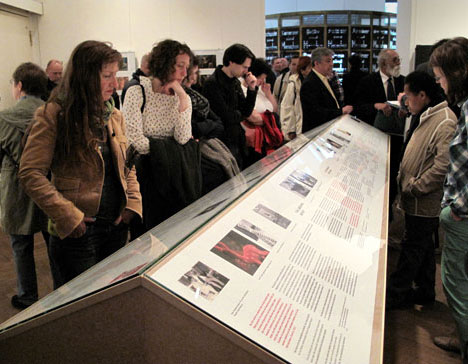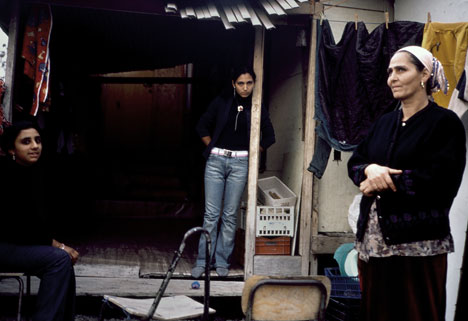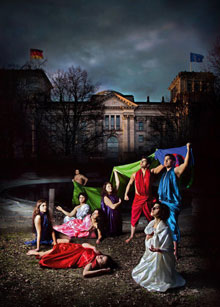PRESS TEXT re “Perpetual Romani Gypsy Pavilion” at the Venice Biennalle in 2009
Source: http://www.eurozine.com/culture-as-opportunity/
Culture as opportunity?
On Sinti and Roma art and culture
Hamze Bytyci
Culture work provides Sinti and Roma people with opportunities to develop personally, combat negative modes of representation and intervene politically too. As such, it counterbalances the obstacles that the everyday realities of educational disadvantage and racism create, writes Hamze Bytyci. He takes two surveys on German Sinti and Roma from the past decade as his point of departure for sketching the artistic and cultural landscape, principally in Berlin, surrounding the Sinti and Roma.
Art is here to provide individuals the freedom to express their own feelings, views or identity without having to give too much heed to social conventions. Yet when it is about the art and culture of Sinti and Roma, the situation seems to be a bit more complex. Here there are a number of prejudices, stereotypes or simply certain expectations that come to bear, be it on the part of the majority society or that of members of this minority itself. They influence not only the everyday life of many Sinti and Roma, but also, possibly their artistic production, be it only through the compulsion of having to react to and reflect on the overall situation.

The Roma Image Studio. Photo: Nihad Nino Pusija /fotofabrika.de
In order to be able to assess the social effect that the art and culture work of Roma and Sinti has, it is necessary to first take at least a cursory look at the situation of the Sinti and Roma in Germany. This, however, proves difficult since there are no official studies on the situation of the non-German Roma in Germany. The following information is thus based on two studies that focus only on the situation of the German Sinti and Roma. It can be assumed that the situation of the non-German Roma – in particular among the Roma who have moved to Germany from Romania and Bulgaria – is even graver, especially in the field of education and in terms of economic and social factors. With regard to discrimination and racism, we can, by contrast, assume that the experience of the German Sinti and Roma is not much different from that of the non-German Roma.
The representative survey of the Central Council of German Sinti and Roma on racism against the Sinti and Roma in Germany was carried out in 2006, with about 309 persons respondents. 76 per cent of the participants responded affirmatively to the question on whether they had been discriminated against often – in the workplace, by neighbors, in restaurants or in other places. 40 per cent of those interviewed believed that their children or grandchildren were not sufficiently supported in school. The study also drew attention to the discriminating practice of the media in reports when references were made to delinquent or criminal acts being committed by a member of a minority. 90.3 per cent of the respondents affirmed that this media coverage elicited a fear of prejudice among them as members of a minority. 1
The more recent study on the present-day educational situation of German Sinti and Roma, carried out by RomnoKher GmbH between 2007 and 2011, questioned 275 German Sinti and Roma from three generations about their educational situation. Compared to the 2006 study, the findings here are even more shocking. 81.2 per cent of respondents had personally experienced discrimination. The study concluded: “Experience in school is strongly informed by open and hidden discrimination in the form of everyday anti-ziganist insults and prejudices on the part of other schoolchildren. The teachers here do not seem to intervene in a professional way.”2 Moreover, according to the study, 13 per cent of those interviewed did not attend any school whatsoever, with this percentage among the majority population probably being lower than one per cent. 44 per cent of those questioned had no school diploma (as opposed to 7.5 per cent among the majority population).3
These two studies show not only the current situation of the Sinti and Roma in the field of education and with regard to widespread racism. They also hint at two important ways in which cultural and artistic work by or with the Sinti and Roma can have a social impact. First, culture work represents an opportunity for the Roma – in particular the Roma youth – to develop personally. It enables them to acquire new skills and experience success. This way, a contribution is made to encouraging an interest in (non-)formal education and including the Roma in meaningful, positive activities. Second, art and culture work has the potential to reach a larger public that includes the majority population, and to refute the images of Sinti and Roma that are common in the media – and thus to reduce prejudices and stereotypes and counteract exoticizing representations.
Taking these aspects into account, I would now like to take a closer look at several Roma art and culture projects.
André J. Raatzsch: The Roma Image Studio
The first, and probably most topical, project is an exhibition and long-term photo-platform. The project was curated by André J. Raatzsch in collaboration with Lith Bahlmann and Emese Benkö and opened at the Galerie im Saalbau in Berlin-Neukölln in 2013: “The Roma Image Studio is an artistic and critical platform that links the representation of the European Roma with the re- and deconstruction of Roma-identity, taking into account photography, photo-archives and the related photographic discourse. […] On the basis of iconographic imagery from international photo-archives and collections, photo albums and artistic photographs, the exhibition initiates the over-due inter- and transdisciplinary discourse on the de- and reconstruction of the historical and social memory of the European Roma”.4

The Roma Image Studio. Photo: Nihad Nino Pusija /fotofabrika.de
Raatzsch sees his art as an instrument to de-exoticise and de-romanticize the “Sinti and Roma image”. “In my artistic work I have been focusing since 2007, when I participated in the First Roma Pavilion at the Biennale in Venice, on the question of Roma depictions of the present. To this end, I present contemporary photography and photographic archives as well as sculptures in performative artistic contexts which do not belong to the conventional romanticizing and exoticizing exhibition practice”.5 The goal of having an effect on the majority society clearly moves to the foreground here.
Moritz Pankok: Gallery KAI DIKHAS
The Gallery for Contemporary Art of Sinti and Roma exhibits artists from all over the world and was founded in 2011. Its artistic director is Moritz Pankok and the gallery is located in the Aufbau Haus in Kreuzberg in Berlin. As one can read on the gallery’s website: “Apart from the Roma Museum in Brno (Czech Republic) and the Regional Museum of Tarnow (Poland), which are, however, general museums and not pure art museums, there is up to today no permanent place, which devotes itself to the contemporary art of the Sinti and Roma, which investigates, spreads and introduces it to a bigger public. Roma Artists often lack access to a public, which the artist needs for his work and living, particularly. The gallery is to help to create remedy to this circumstance”.6
Moreover, it has created a new free space, which enables Roma artists to develop and present their talents and skills. The gallery contributes to an inner and outer emancipation of Roma culture”.7 The attempt to bring about changes and positive developments within the “Sinti and Roma art scene” is thus clearly expressed.
As the curator of (probably) the only gallery for visual arts by Sinti and Roma in Germany, Moritz Pankok describes his goal of presenting the heterogeneity of this area of art to a larger public:
“I think the gallery shows quite clearly that there is a very large diversity and very different ways of thinking within the minority, that there are people who make small, moving installations out of recycled materials, just as there are painters who make two-by-three-meter oil paintings that have absolutely nothing to do with, for example, a nomadic art”.8
Nihad Nino Pusija: Roma é Roma – Roma in Rome
For nine years, Nihad Nino Pusija has been visiting the same Roma families again and again – families that live in camps around Rome, following their life situation. In the process, he has found “young gladiators, proud adolescents, disillusioned persons and those full of life, trying under the most difficult circumstances to secure their survival”.9 His photos were shown at the Gallery in fall of 2012.

From the Roma in Rome exhibition. Photo: Nihad Nino Pusija /fotofabrika.de
In the press release on his exhibition he explains that his goal is to deconstruct the clichéd and homogenizing image of Sinti and Roma: “There where I live and work, I trace microcosms, document changes on a small scale and capture inconspicuous things so as to create a more all-encompassing image of my surroundings with the series I have created”.10
Hamze Bytyci and Rafael Badie Massud: Romeo rennt
Romeo rennt is a theatre piece that was rehearsed by 14 young people at the akademie der autodidakten and performed at the Ballhaus Naunynstrasse in May 2012. Following an odyssey from the Balkans to Berlin, Romeo finally ends up in a circus: here an impossible wedding takes its course, rituals go off kilter and the prism of perspectives keeps on turning.

A scene from. Photo: Nihad Nino Pusija /fotofabrika.de
The theatre performance Romeo rennt was created together with young people who had the chance to contribute their input to the piece in the form of their ideas and their personalities. An important aspect was the experience of success, which was additionally reinforced by the fact that the tickets for both performances were sold out. This is an effective method of non-formal education, which has the potential to influence the development of young people in the long term. Since the theatre piece dealt intensively with the various “Roma traditions” and the stereotypes harboured towards the Sinti and Rima, it had an especially big impact on the audience.
Ivor Stodolsky and Marita Muukkonen: Perpetual Gypsy Pavilion
Perpetual Gypsy Pavilion is a “traveling pavilion”, which was opened during the Venice Biennale in 2009. It was a spontaneous reaction to two things: the official Roma pavilion being cancelled at short notice and, at the same time, Berlusconi’s government seriously violating the rights of the Roma living in Italy.11 The Roma pavilion became part of ten national pavilions at the Biennale – it took on the form of a “postcard from Venice” on which one could leave one’s own fingerprint. 12
As can be gleaned from the interview with Ivor Stodolsky, the goal of the Perpetual Romani-Gypsy Pavilion was mainly to address the worldwide contemporary art scene and to (re-)present “Roma art” to this audience. “At that time in Venice, it was very important that everything came out via e-flux. At the last moment, we convinced e-flux to do this free of charge, and it was revealed that all of the curators were still there. The Hungarian pavilion was part of it, the Swedes, the Norwegians – ten countries altogether. This was the first time that “gypsies” participated in the international art scene within the other pavilions. […] This Perpetual Pavilion was very political, directed against Berlusconi’s politics – people were being killed on the streets, in Naples children were found dead on the beach. The audience at the time was contemporary art and, because it was the largest and most important event of contemporary art, all eyes were directed at Venice”.13 The intention was somewhat different than in the other projects, for the idea was not just to reach a broad public but, above all, to have an influence on the representation of the Roma at a high political level. This could be called the third possibility of a social impact of art and culture of Sinti and Roma.
Cultural identity and self-representation
I would like to pose the following question: is there such a thing as Roma cultural identity? The answer coming from the studies and interviews I did is clear enough. There is no one cultural Roma identity. There are various heterogeneous identities, which are composed of regional and individual elements.
What strikes me as especially important is the question of self-representation. The Sinti and Roma must – and would like to – be involved in the decision regarding how they are to be represented.
In the press release on the exhibition Roma é Roma by Nihad Nino Pusija, for instance, the widespread representation of the Roma by others is questioned and Pusija’s Roma background is highlighted as an important advantage:
“The photographic image of ‘gypsies’ has to date usually been shaped by outsiders, not by members of the minority itself – usually without consent or against the will of the portrayed persons. Thus the same, classical stereotype of otherness is passed on and addressed, without probing behind the homogenous surface. Given his background it is easy for him to become part of the photographed scene himself and thus to approach the portrayed person more closely than almost anyone else.
As a wanderer between worlds, Nihad Nino Pusija seeks out new aspects of the reality of his minority, thus liberating the self-image of the Roma from outside influences, from the gaze of the other. The medium of photography thus serves to process identity and to re-assimilate the self-image”.14
Moritz Pankok, who has no Roma background, would like, as curator of a Sinti and Roma gallery, to provide Sinti and Roma artists with a space in which they can present themselves: “I do not want to influence too much my artists with any thematic rules. Rather, it should be a space that is available to them for presenting themselves”.15
Pankok goes further still: “It is not the task or the duty of a minority to worry about being understood by the majority but rather the majority society having the means in its hands to inform and to approach people and give them space in communication and the media”.16
When it is about the art or the culture of the Sinti and Roma, the tendency toward folklore or kitsch and the homogenization of the diverse minority is often discussed. André J. Raatzsch points out that there is folklore in all nations:
“This folklore is shaped, continued, newly formulated, newly commented on by institutions such as museums, galleries, cultural centres, educational centres. In the case of the Roma, this entire movement, this entire change has been happening since the 1970s. […] And we also have to see very precisely that this movement is very slow. Why? Because the Roma as a minority only have very few instruments, institutions that can define this very precisely, cultivate and communicate this in the long-term. And I believe that in the future, there will simply be a separation in Roma culture between folklore, contemporary art and regional or local art.”17
Folklore is thus a legitimate part of “Sinti and Roma culture”, but it should not be reduced to it. Rather the point should be to fight against the tendencies that exoticize and homogenize “Sinti and Roma art.”
Moritz Pankok sees in art and the means that are available to art a possibility for addressing and eliminating stereotypes, for instance, through humour:
“It is also so that art often also facilitates a humourist approach which, if dealing with a theme such as racism in a scientific or media theoretical way, would be very difficult. […] It would actually be very liberating. And precisely this is also the freedom that an artist has, for instance, in Damien Le Bas’ works, where there are many very bad stereotypes. […] But as regards ‘dealing with clichés’, one has to identify the intentions. As, for example, in Damien Le Bas, one finds clichés again and again that are certainly used as a means of communication – but always with the goal of making them visible, revealing and breaking them. But with humour.”18
Again and again it is asked whether the name “Roma art” or “Roma artists” is not only used (or is abused) as a sort of “door opener”, a sort of “entrance ticket to the world of art”. Responding to the question of the senior producer of Deutschlandradio Kultur as to whether “Sinti and Roma art” is “also a label which can be used to protect oneself or even for promoting oneself – hey, look here, here comes the art of a discriminated minority but you are definitively not allowed to be against it”, André J. Raatzsch answered as follows:
“[…] To be honest, it would, on the one hand, be stupid if one wouldn’t use that, while on the other hand, it is important what one achieves with it, what one can ruin with it. How can you structure it so that the emancipation processes in which the protagonists participate here as Roma and want to participate in, can later achieve this, as, for example, happened with Black Culture in the USA: it is recognized today, established in the international art world”.19
Moritz Pankok’s response is not much different: “The people here are not being exhibited simply because they are Roma and take a brush in their hand. Their art also has to convince me and that has a whole lot to do with artistic or aesthetic quality.”20
Similar to Pankok, what is most important for Ivor Stodolsky is the quality of artistic production. Moreover, he also makes sure that the works selected by him also fit into the current artistic concept: “Yes it is a ticket. But I think there are so many tickets here! You also cannot say: I am the new Beatles – then you don’t have a ticket! [laughs] You also have to do something that has not yet been done”.21
- Representative survey of the Central Council of German Sinti and Roma concerning racism against the Sinti and Roma in Germany, 11 October 2006, zentralrat.sintiundroma.de/content/downloads/stellungnahmen/UmfrageRassismus06.pdf
- Daniel Strauß, “Zehn Ergebnisse der Bildungsstudie und Empfehlungen”, (“Ten results of the survey of education and recommendations), RomnoKher, 2006, stiftung-evz.de/fileadmin/user_upload/EVZ_Uploads/Handlungsfelder/Handeln_fuer_Menschenrechte/Sinti_und_Roma/06_zusammenfassung-bildungsstudie-sinti-2011.pdf
- Ibid.
- André J. Raatzsch: “Ein Interview mit mir selbst” (“An interview with myself”), EU-INFOTHEK, 4 April 2013, www.eu-infothek.com/article/andre-j-raatzsch-ein-interview-mit-mir-selbst
- Ibid.
- Moritz Pankok, “Kai Dikhas: Place to see”, 2010, www.kaidikhas.de/en/gallery
- Ibid.
- Ibid.
- Nihad Nino Pusija, “Roma é Roma — Roma in Rom”, Press release, 2012, www.kaidikhas.de/de/exhibitions/roma_E_roma_1/text
- Ibid.
- See: www.perpetualpavilion.org/
- Interview with Ivor Sodolsky, 20 April 2013
- Ibid.
- Nihad Nino Pusija, “Roma é Roma — Roma in Rom”, Press release, 2012, www.kaidikhas.de/de/exhibitions/roma_E_roma_1/text
- Interview with Moritz Pankok, 29 March 2013
- Ibid.
- Jenseits von Folklore-Kitsch: André J. Raatzsch im Gespräch mit Joachim Scholl (“Beyond folklore kitsch: André J. Raatzsch in conversation with Joachim Scholl), www.deutschlandradiokultur.de/jenseits-von-folklore-kitsch.954.de.html?dram:article_id=242663
- Interview with Moritz Pankok, 29 March 2013
- Jenseits von Folklore-Kitsch (Beyond Folklore Kitsch), http://www.deutschlandradiokultur.de/jenseits-von-folklore-kitsch.954.de.html?dram:article_id=242663 (April 24, 2013)
- Interview with Moritz Pankok, 29 March 2013
- Interview with Ivor Stodolsky, 4 April 2013
Published 7 January 2014
Original in German
Translation by Erika Doucette
First published in IG Kultur Österreich (ed.), Romanistan is Everywhere: Tracing Treacherous Terrain, in-house publication, 2013
© Hamze Bytyci Eurozine
